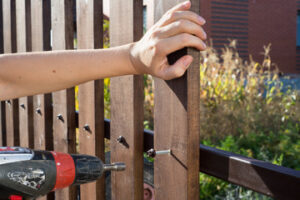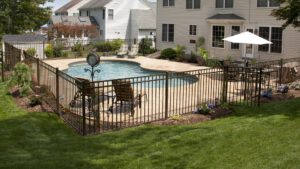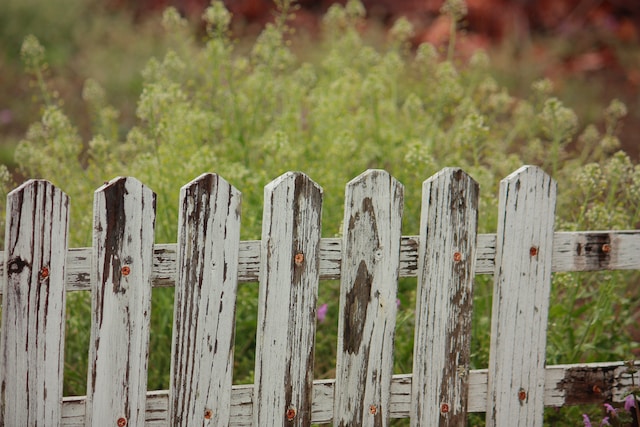Round Rock Fence Repair covers a variety of services. It includes everything from fixing holes in your fence boards with wood filler to replacing a damaged panel.

If a post is leaning, a contractor can install support braces or lay concrete to keep it from falling. They can also sand down and stain the affected section of your fence to match.
Whether wooden or metal, fence posts can become unseated and wobbly or rotted at the base. Leaving these issues unchecked can cause them to fall, pulling the rest of the fence with them and requiring costly replacement.
First, figure out why the post is leaning. It could be a simple matter of something pushing against it, like a tree root or garden decor, but it’s more likely that the post has rotted. You can test the integrity of a wooden fence post by pressing on it with moderate force. If the post resists, it’s still good; if it sinks in easily, it has rotted, and the damage may be spreading quickly.
Next, clear the area around the problem post to get a better look at what’s going on. You’ll probably want to put a tarp nearby, as it will make cleanup and refilling the hole much easier. Start digging using a shovel or a demolition bar, and dig around the base of the post until you hit concrete. If there is concrete, this may mean you’ll need to break it out with a sledgehammer or dig it up completely.
If the post isn’t in concrete, you can use a post mender to fix it. These products are sold at most home improvement stores, and you’ll also need some galvanized hex-head screws to fasten the mender to the post. To install the mender, simply hammer it in until it has penetrated one foot or the depth recommended by the product manufacturer. Next, drive at least four galvanized hex-head screws through the pre-drilled pilot holes to attach the mender to the fence post.
If you can’t replace the post, consider using a fence panel as a brace. Screw a block of wood to the posts on either side of the damaged panel and under the bottom rail. This will help support the panel, but it’s not a long-term solution. Ideally, you’ll need to either rebuild the fence with stronger concrete or switch to a different type of fencing that’s less prone to environmental conditions.
Leaning or Falling Panels
Depending on the weather, and whether your fence is made of wood or metal, some fencing materials may start to lean over time. This can happen due to extreme winds or rain. It can also happen if your fence is not properly anchored, or if the ground underneath it is unstable. If your fence starts to lean, it is important to get it fixed as soon as possible. This will help prevent further damage, as well as make your garden look more tidy.
A typical wooden fence repair job cost is around $115 to $150. This includes labor and materials to replace the damaged panels, and staining or painting them to match the rest of the fence. If you have a wooden fence that is not being repaired, you should consider getting it stained or painted every two years to help preserve the life of the wood.
When a fence is repaired, it can take between one and three days to complete. During this time, it is important to keep children and pets away from the work area. This will ensure that the contractor has a safe working environment. It is also helpful to remove any obstacles that could prevent the contractors from accessing the damaged area, such as lawn furniture, statues, kids’ toys, barbecue grills, or potted plants.
In addition to repairing or replacing fence panels, you may also need to replace the arris rail. The arris rail is the horizontal piece that runs across the back of each panel. This can be damaged in a storm, and in some cases may need to be replaced completely.
If your fence is made of concrete, it can be more expensive to repair than a wooden or metal fence. This is because it takes more materials to repair. Concrete is also more brittle than other materials, so it can be broken easier. Concrete repairs typically cost between $250 and $800.
It is also recommended to seal your fence with a waterproofing product every two years. This will help protect the wooden materials from water and rot. Using a waterproofing product will also help prevent the need for frequent wood fence repairs.
Post Caps
Post caps add an attractive finish to the top of fence posts. They also perform an important function — they cover the end grain of posts that would otherwise absorb moisture and lead to cracking, rot or even premature failure of the post itself.
Most post caps are made from wood or galvanized steel, but they’re available in a wide range of materials, colors and styles to suit your fence or deck design. Some are welded on or slotted onto the top of fence posts, while others are simply glued to the top of the post. Regardless of the type of post cap you choose, it is important to ensure that it fits properly on the post so that the post’s ends are not exposed.
Many wooden post caps are constructed using miter joints. These are the angled cuts that connect two pieces of wood together at right angles to each other. However, over time these cuts can separate and expose the ends of the wood to moisture. Post caps prevent this by covering the ends of your posts and keeping them dry, extending the life of your wood fence.
The first step in replacing your post caps is to remove the old ones. This can be done easily enough by using a pair of nail nippers to cut the nails on each side and then tapping off with a hammer. Alternatively, you can use a power drill and hex bit to drive out the screws that hold the cap.
Once you have removed the old caps, measure the post and find a cap that fits properly on it. Be sure to account for the thickness of the cap and the length of the post itself, since these can make a difference in how well the cap seals over the end of the post. Once you have found the proper size cap, apply construction adhesive to the base of the cap and firmly press it onto the top of your fence post. Allow the glue to dry according to the manufacturer’s instructions.
Once your new post caps are attached, they will need to be painted or stained to match your existing fence. While this can be a time-consuming project, it is well worth the effort for a finished look that will last longer than your fence itself.
Pest Control
After your maintenance crew takes care of the basic fence repairs, you need to protect the structure from pests. A pest infestation is any species in large enough numbers to cause property damage, affect the health of building occupants or simply become a nuisance. Infestations can result in a loss of productivity for maintenance workers, create sanitary and safety problems for occupants or destroy exhibited artifacts.
A pest control strategy may include both suppression and prevention. Suppression is the goal of reducing a pest population to a level that no longer causes unacceptable harm. Prevention is possible when the conditions that make a pest thrive can be changed.
Preventive steps include removing sources of food, water and shelter. Store food in sealed containers and dispose of garbage regularly with a tight lid. Keep lawns, landscaping and firewood piles away from structures. Clutter and debris provide hiding places for pests, so remove items that could provide them with shelter. Caulk cracks and crevices, especially those around pipes.
Some pests can be kept to a minimum through a combination of preventive measures and humane traps or baits. Regular pest inspections can spot a problem in its early stages and minimize the amount of damage it causes.
For a more comprehensive pest control program, you should have a pest management professional inspect the site and offer recommendations. They can also advise you on ways to make your facilities less attractive to pests.
Regularly check the fence for signs of rot, sagging or other damage. Address any issues promptly. A small problem can quickly escalate if left unchecked. Conducting a thorough inspection once a year can help you to catch and repair problems before they become serious. This is a good opportunity to do the basics like replacing broken boards and hammering in loose nails.



